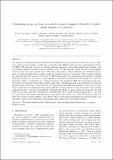Files in this item
Estimating group size from acoustic footprint to improve Blainville’s beaked whale abundance estimation
Item metadata
| dc.contributor.author | Marques, Tiago A. | |
| dc.contributor.author | Jorge, Patricia A. | |
| dc.contributor.author | Mouriño, Helena | |
| dc.contributor.author | Thomas, Len | |
| dc.contributor.author | Moretti, David J. | |
| dc.contributor.author | Dolan, Karin | |
| dc.contributor.author | Claridge, Diane | |
| dc.contributor.author | Dunn, Charlotte | |
| dc.date.accessioned | 2020-08-22T23:35:05Z | |
| dc.date.available | 2020-08-22T23:35:05Z | |
| dc.date.issued | 2019-12-15 | |
| dc.identifier | 260702595 | |
| dc.identifier | e7f4f0d0-6e1d-4af6-aa93-cddaae911e66 | |
| dc.identifier | 85070993588 | |
| dc.identifier | 000488301300046 | |
| dc.identifier.citation | Marques , T A , Jorge , P A , Mouriño , H , Thomas , L , Moretti , D J , Dolan , K , Claridge , D & Dunn , C 2019 , ' Estimating group size from acoustic footprint to improve Blainville’s beaked whale abundance estimation ' , Applied Acoustics , vol. 156 , pp. 434-439 . https://doi.org/10.1016/j.apacoust.2019.07.042 | en |
| dc.identifier.issn | 0003-682X | |
| dc.identifier.other | ORCID: /0000-0002-2581-1972/work/60887382 | |
| dc.identifier.other | ORCID: /0000-0002-7436-067X/work/60887403 | |
| dc.identifier.other | ORCID: /0000-0002-4274-7239/work/60887701 | |
| dc.identifier.uri | https://hdl.handle.net/10023/20499 | |
| dc.description.abstract | The numbers of animals in groups and the density of Blainville’s beaked whale Mesoplodon densirostris (Md) were estimated using passive acoustic data collected on the Atlantic Undersea Test and Evaluation Center (AUTEC). Md typically associate in groups, producing ultrasonic echolocation signals when foraging, and are routinely detected year-round on the AUTEC range. AUTEC includes a large network of hydrophones cabled to shore that can be used to detect Md echolocation signals. Using a first data set, with known group sizes, we used generalized linear models (GLMs) to model group size as a function of the acoustic footprint of a detected deep dive as perceived on the AUTEC hydrophones. The most important variable to explain group size was the detected click rate (total number of clicks detected divided by total length of vocal period duration). Using a second data set, covering 3 separate time periods in 2011 with automated group dive detections, we estimated beaked whale density using a dive counting approach. False positives were removed through manual inspection, removing dives with biologically infeasible characteristics. This led to a total of 8271 detections of beaked whale deep dives, with the average number per day in the three time periods considered being 75, 80 and 76 respectively. Using selected GLM, the mean estimated group size was 2.36 (95% CI 2.15-2.60), 2.30 (95% CI 2.08-2.56), and 2.33 (95% CI 2.19-2.58) whales/group for the 1st, 2nd and 3rd time period. Md density was estimated at 15.8 (95% CI 13.6-21.9), 16.5 (95% CI 13.8-22.4), and 15.8 (95% CI 13.2-21.2) whales/1000km2, respectively. These results support findings from previous studies, and will allow a more precise estimation of group sizes and densities for Md in future research. | |
| dc.format.extent | 335024 | |
| dc.language.iso | eng | |
| dc.relation.ispartof | Applied Acoustics | en |
| dc.subject | Blainville’s beaked whales | en |
| dc.subject | Echolocation | en |
| dc.subject | Dive counting | en |
| dc.subject | Density estimation | en |
| dc.subject | Group size | en |
| dc.subject | Passive acoustic | en |
| dc.subject | GC Oceanography | en |
| dc.subject | QH301 Biology | en |
| dc.subject | DAS | en |
| dc.subject.lcc | GC | en |
| dc.subject.lcc | QH301 | en |
| dc.title | Estimating group size from acoustic footprint to improve Blainville’s beaked whale abundance estimation | en |
| dc.type | Journal article | en |
| dc.contributor.sponsor | Office of Naval Research | en |
| dc.contributor.institution | University of St Andrews. School of Mathematics and Statistics | en |
| dc.contributor.institution | University of St Andrews. Scottish Oceans Institute | en |
| dc.contributor.institution | University of St Andrews. Centre for Research into Ecological & Environmental Modelling | en |
| dc.contributor.institution | University of St Andrews. Statistics | en |
| dc.contributor.institution | University of St Andrews. Marine Alliance for Science & Technology Scotland | en |
| dc.contributor.institution | University of St Andrews. School of Biology | en |
| dc.identifier.doi | https://doi.org/10.1016/j.apacoust.2019.07.042 | |
| dc.description.status | Peer reviewed | en |
| dc.identifier.grantnumber | N00014-15-1-2648 | en |
This item appears in the following Collection(s)
Items in the St Andrews Research Repository are protected by copyright, with all rights reserved, unless otherwise indicated.

